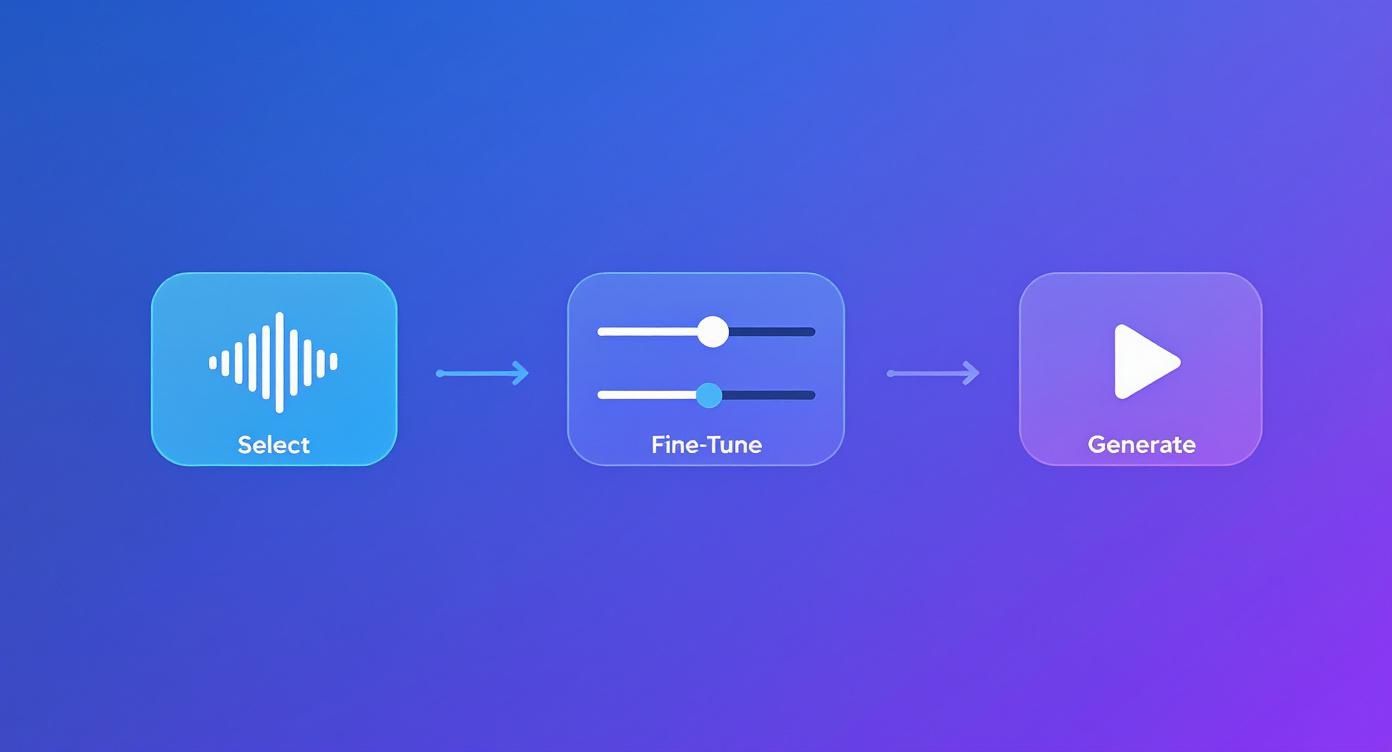Create Your Own AI Girlfriend 😈
Chat with AI Luvr's today or make your own! Receive images, audio messages, and much more! 🔥
4.5 stars

Let's be honest, those old, robotic text-to-speech voices just don't cut it anymore. We've all heard them—stiff, lifeless, and completely devoid of personality. AI character voice text-to-speech is about flipping that script entirely. It's about using artificial intelligence to breathe life into text, generating unique voices that are packed with personality.
This isn't just a tech upgrade; it's a creative one. We're talking about designing custom vocal personas from the ground up for your games, chatbots, and content. The goal is to give your characters real emotional depth and authenticity, creating something that actually connects with your audience.
Beyond Robotic Voices: The New Creative Frontier

The era of monotone, one-size-fits-all text-to-speech is officially over. We're in a new world now, one where AI character voices offer rich emotional range and distinct personalities, completely changing the feel of digital experiences. Creators and developers are finally ditching those generic voices for custom-built personas that forge a genuine connection with users.
Think about it. This is so much more than just turning words into audio; it's about crafting an identity people remember. Imagine a side character in a video game whose voice carries the weight of a cynical, weary backstory. Or an AI companion whose tone is genuinely warm and encouraging. That's the kind of detail that makes digital interactions believable and, more importantly, engaging.
The Rise of Expressive AI Audio
What’s driving this change? A massive demand for more human-like digital interactions. The global Text-to-Speech (TTS) market was valued at around USD 4.0 billion in 2024 and is expected to rocket to USD 7.6 billion by 2029. You can dig into the specifics of this growth on Archive Market Research. This boom is happening because the tech has finally caught up, making voices that sound less like machines and more like characters with actual feelings.
This evolution is a game-changer across the board:
- Immersive Storytelling: Podcasters and audiobook producers can now create multi-character dramas without the expense of a full voice cast.
- Dynamic Gaming: Developers can generate thousands of unique dialogue lines for NPCs, making their worlds feel vibrant and alive.
- Personalized Assistants: AI companions can be designed with voices that users actually enjoy listening to, which helps build a much stronger user bond.
Making Custom Voices Accessible
Not too long ago, creating a custom voice was a nightmare—a complex, expensive process that only big studios could afford. Thankfully, that's all changed. Platforms like Luvr AI are putting this powerful technology into the hands of creators everywhere. You no longer need a professional recording studio or a team of audio engineers to design a voice that perfectly captures your character’s soul.
The real magic here is how modern AI voice tech is leveling the playing field. Individual creators now have the tools to produce audio experiences with the same emotional punch as a massive, big-budget production.
And that's exactly what this guide will walk you through. We’ll go from the spark of a character idea all the way to generating, training, and deploying their unique AI voice. It’s time to stop settling for off-the-shelf audio and start building personalities that truly resonate.
How to Design a Memorable AI Voice Persona

Before you even think about generating a single sound wave, you need a blueprint. A truly memorable AI voice isn't just a label like 'friendly' or 'serious'; it’s born from a persona that's been fleshed out with real depth. Authenticity comes from nuance, and that means getting to know your character long before you worry about their vocal cords.
This is where the magic really happens. The design phase is what separates a voice that just reads text from a personality that genuinely communicates. When your AI character voice text to speech output is grounded in a solid persona, every word feels cohesive and believable.
This level of detail is becoming non-negotiable. The AI-driven Text-to-Speech (TTS) market is on a massive growth trajectory, projected to explode from USD 5.03 billion in 2024 to an estimated USD 13.08 billion by 2032. This surge is all about the demand for natural, responsive voices in everything from smart assistants to immersive companions. You can dig into the numbers yourself in this comprehensive market analysis.
Defining Core Vocal Identity
The first thing to do is get past the surface-level adjectives. Instead of just "calm," ask yourself why they're calm. Is this a battle-hardened veteran who has seen it all? Or a gentle therapist guiding someone through a tough time? The motivation behind the emotion is what truly shapes the delivery.
Start with the foundational questions:
- What's their backstory? Someone who grew up in luxury will carry themselves—and their voice—differently than someone who fought for everything they have.
- What drives them? Ambition, love, and revenge each have their own unique vocal energy.
- Who are they talking to? The way they speak to a trusted friend will be a world away from how they address an enemy.
A detailed persona document is your most powerful tool. It acts as a north star during the voice generation and refinement process, ensuring every adjustment you make serves the character's identity.
By building this foundation, you create a consistent framework. This gives the AI the context it needs to deliver lines with genuine intention, making the character far more compelling. For some great examples of how deep these personalities can go, check out the range of pre-defined characters available on Luvr AI.
Mapping Emotional and Situational Range
Nobody speaks in a monotone, and your AI character shouldn't either. A great persona has a dynamic emotional range that adapts to the situation. You need to map out precisely how their voice shifts under pressure, in moments of joy, or when they’re being sarcastic.
Think through a few scenarios to define their vocal dynamics:
- High-Stakes Conflict: Does their pitch get higher and their pace quicken? Or do they become unnervingly quiet and deliberate?
- Intimate Conversation: Do they adopt a softer, breathier tone, or does their voice maintain its usual cadence?
- Delivering Bad News: Is their delivery slow and empathetic, or blunt and to the point?
Mapping these reactions provides a clear, actionable guide for the AI. When it’s time to fine-tune specific lines, you'll know exactly which emotional state to aim for. This is the kind of detailed planning that transforms a standard AI character voice text to speech into a performance that sticks with people.
Before generating the voice, it's incredibly helpful to organize these thoughts. A checklist ensures you've considered all the crucial attributes that make a voice feel real and consistent.
Persona Voice Attribute Checklist
| Attribute Category | Key Considerations | Example (For a 'Wise Old Mentor' Character) |
|---|---|---|
| Core Demographics | What is their age, gender, and regional background? How does this influence their accent? | Age: 70s, Gender: Male, Accent: A soft, neutral, almost timeless accent. |
| Personality Traits | Are they confident, timid, arrogant, or warm? How does this affect their vocal baseline? | Confident but gentle. Voice is steady and rarely raises in volume. |
| Vocal Pitch | Is their natural voice high, low, or somewhere in the middle? Does it crack when emotional? | Low to mid-range. Becomes slightly deeper when offering serious advice. |
| Pacing & Cadence | Do they speak quickly and energetically, or slowly and deliberately? | Slow and measured. Pauses frequently for emphasis, never rushes his words. |
| Emotional Triggers | What specific situations cause their voice to change? (e.g., anger, surprise, joy) | Anger: Voice doesn't get louder, but colder and sharper. Joy: A low chuckle. |
| Verbal Tics | Do they have any unique speech habits, like sighing, clearing their throat, or using filler words? | Tends to start profound statements with a soft, thoughtful "Hmm..." |
Using a checklist like this gives you a tangible reference point, turning abstract ideas about your character into concrete, actionable parameters for the AI. This is how you build a voice that doesn’t just speak—it tells a story.
Bringing Your Voice to Life with Luvr AI
Alright, you've got your persona blueprint. Now for the fun part: taking those ideas off the page and turning them into a voice you can actually hear. This is where your vision for an ai character voice text to speech starts to feel real, and the Luvr AI platform is built to make that happen.
Think of the first step like casting an actor. You need to pick a base voice model. You're not looking for the final, polished performance just yet. Instead, you're searching for a foundational voice with the right core ingredients—maybe it's a certain pitch, a natural warmth, or a bit of a gravelly texture that just feels right for the character you've designed. This choice is your starting block.
This push for unique, personalized voices is exactly why the voice synthesis market is booming. The Text-to-Speech (TTS) industry is on track to be worth around USD 28.02 billion by 2034. Why? Because creators and companies are moving beyond robotic defaults to deliver voices that feel genuinely human, giving them control over everything from emotional tone to speaking pace. You can dig into more of the data on this expanding market over on expertmarketresearch.com.
Sculpting the Voice with Emotional Parameters
Once you've picked your base voice, the real artistry begins. This is where you get hands-on with Luvr AI's controls, dialing in the specific emotional nuances you mapped out in your persona document. Be prepared to experiment and tweak things a bit.
Here’s a quick look at the Luvr AI voice builder interface. You can see some of the key levers you'll be pulling to shape the sound.
This level of control is what lets you go beyond simply "happy" or "sad" and create a truly specific performance.
All that detailed planning you did earlier? This is where it pays off big time. Pull up your persona checklist and start making targeted adjustments.
- Pitch Variation: Got a character who gets excited easily? Try increasing the pitch variability to make their voice more dynamic and expressive.
- Pacing and Pauses: For a thoughtful character, like our 'Wise Old Mentor,' you'd want to slow down the pace and add longer, more meaningful pauses between phrases.
- Tone and Intensity: Is your character delivering a sarcastic line? You can subtly adjust the tone to carry that snarky subtext, making the performance feel much more authentic.
Iteration and Refinement
Let's be real: your first attempt is almost never the final one. The secret to a truly lifelike ai character voice text to speech is a simple cycle: generate, listen, refine, repeat. Don't just test the voice with a few random words; feed it a variety of lines from your actual script that showcase different emotional states.
Pro Tip: Don’t just test single words or short phrases. Use full sentences that reflect your character's typical speech patterns. This gives you a much better sense of the voice's natural flow and cadence in a real-world context.
Listen with a critical ear. Does the voice actually match the personality you imagined? If your stoic, hardened warrior sounds a little too cheerful, dial back the pitch modulation. If your high-energy sidekick sounds sluggish, crank up the pacing. This hands-on refinement is what separates a good voice from a truly great, believable one.
Ready to give it a shot? Head over to the Luvr AI character builder and start applying these techniques to your own persona.
Training and Refining Your Custom AI Voice
Getting that initial voice clone is really just the starting line. The real magic, the part where you create an ai character voice text to speech experience that genuinely connects with people, happens in the training and refinement stage. This is where you transform a pretty good voice into a persona that feels truly alive and consistent.
I like to think of it less like a technical process and more like coaching an actor. Your first voice generation is the raw talent. Now, it's your job to direct the performance, shaping it with specific feedback and high-quality source material.
It’s an iterative loop. You pick your base voice, you tweak the settings, you generate the audio, and you listen. Then you do it again.

This simple flow—select, fine-tune, generate—is the core of the whole thing. That middle step, the fine-tuning, is where you'll spend most of your time chasing that perfect delivery.
High-Quality Audio: The Foundation of a Great Voice
There's an old saying in this field: garbage in, garbage out. It couldn't be more true. The quality of your source audio directly impacts the quality of the final AI voice. You don't need to rent out a professional recording studio, but you absolutely need to capture clean, clear audio.
Here’s what I focus on to get it right:
- A Decent Microphone: That little mic on your headset probably isn't going to cut it. A solid USB microphone is a game-changer; it captures the rich details of a voice without all that annoying background hiss.
- A Quiet Environment: Find a room with minimal echo. Think carpets, curtains, and soft furniture. Shut the door, turn off the air conditioner, and make sure your computer fan isn't screaming. Even tiny background noises can get baked into your AI's voice.
- Consistent Delivery: When you're recording your training script, try to maintain a steady pace and volume. Avoid big, dramatic shifts in your tone unless you're specifically training for a certain emotion. The goal here is to give the AI a solid, clean baseline to learn from.
A quick tip from experience: The AI learns from everything. If your recording has a slight echo because you're in a bare room, the AI will learn to replicate that echo. The result? A voice that sounds weirdly hollow and unnatural.
Training the AI with Varied Scripts
To build a voice that can handle anything you throw at it, you need to feed it a diverse diet of sounds and sentences. Just reading the same few simple phrases over and over will box the AI in, leaving it unable to handle more complex dialogue down the road.
Make sure your training script is a good mix:
- Include short, punchy sentences alongside longer, more descriptive ones.
- Use words that cover a wide range of vowel and consonant sounds.
- Toss in questions, exclamations, and neutral statements to teach the AI different intonations.
For instance, instead of just "My name is Alex," try something like, "Are you absolutely certain this is the right path?" This teaches the AI how your voice naturally rises when asking a question, which makes its future performance far more believable.
Correcting Pronunciation and Enhancing Emotion
Let’s be real: no AI gets it perfect on the first try. You’re going to run into weird mispronunciations or moments where the emotional delivery just falls flat. This is where you roll up your sleeves and start giving feedback.
On platforms like Luvr AI, you have the power to regenerate lines with tweaked emotional settings.
If the AI butchers a name or a piece of jargon, isolate that word. Try generating it by itself, maybe spelling it out phonetically or adjusting the pacing until it clicks.
For the emotional side, just listen. Does a happy line sound boring? Try bumping up the pitch variation. Does a serious moment sound too chipper? Lower the pitch and slow the delivery down a bit.
This back-and-forth loop—generating, listening, and refining—is how you sculpt a basic ai character voice text to speech clone into a dynamic personality that truly embodies your character.
Bringing Your AI Voice to Life in Your Projects
You’ve done the hard work of creating a powerful, custom-trained voice. It's an incredible asset, but it’s not truly alive until it’s out there, interacting with your audience. Now for the most exciting part: putting your AI character's voice to work in the real world. This is where your creation graduates from a set of project files into a dynamic part of an application, website, or game.
So, how do you make this happen? The magic ingredient is an API, which stands for Application Programming Interface.
Think of an API as a secure communication channel between your application and the Luvr AI platform. Your app sends a text request through this channel, and in return, Luvr AI sends back the generated audio in your character's unique voice. The best part is that this exchange happens almost instantly, making it perfect for dynamic, real-time interactions.
Using an API for On-the-Fly Audio
By far, the most common way to use an ai character voice text to speech API is for generating audio on the fly. This is an absolute game-changer for any application where the dialogue isn't set in stone, like a responsive chatbot or an interactive story where the character's lines change based on user choices.
Imagine a player in your video game asks an NPC a spontaneous question. Instead of being limited to a library of pre-recorded lines, your game engine can send that text to the Luvr AI API and get a perfectly spoken response back in a split second. The level of immersion this creates is just phenomenal.
This dynamic capability is also ideal for:
- AI Companions: It allows for natural, unscripted conversations that feel genuinely personal and engaging. You can see how this works by exploring Luvr AI's rich ai character chat experiences.
- Personalized Content: Think about creating custom audio for your users, like a personalized welcome message on your website or tailored narration in an educational app.
- Accessibility Tools: You can instantly convert dynamic web content into natural-sounding audio for visually impaired users, making your platform more inclusive.
What This Looks Like in Practice
Let's ground this in a couple of real-world scenarios.
Say you're building a mobile app that features an AI guide. When the user taps an info button, your app's code simply grabs the relevant text, makes a quick API call, and plays the audio response. It’s that straightforward.
Or, maybe you're creating a marketing video. You could write a script that loops through each line of your narration, sends it to the API, and saves the resulting audio file. From there, you can programmatically stitch the clips together to create the full voice-over without ever opening an audio editor.
The real power of API integration is its sheer scalability. You can generate thousands of unique audio clips on demand without ever manually recording or processing a single one. This frees you up to focus on the creative side of your project.
This approach gives you incredible flexibility. Need to update dialogue, fix a typo, or even A/B test different lines? Just change the text. By connecting your project to a powerful ai character voice text to speech API, you're not just giving your character a voice—you're giving it one that is endlessly adaptable.
Let's Tackle Your AI Voice Generation Questions
Diving into AI voice generation for the first time? It's natural to have questions. Getting the details right from the start is what separates a generic, robotic voice from one that truly brings your character to life. I’ve seen countless creators navigate this process, and a few key questions always come up.
Let's walk through them so you can move forward with confidence.
How Much Audio Do I Really Need to Clone a Voice?
This is probably the number one question I get. While you might see claims of "one-shot" cloning, for a truly high-quality result, you'll want to aim for 1 to 30 minutes of audio. The more clean data you can feed the model, particularly with a range of emotional expressions, the more nuanced and flexible your final AI voice will be.
But here’s the crucial part: quality trumps quantity, every single time.
I'd much rather have 5 minutes of crystal-clear, isolated voice recording than an hour of audio with background music, echo, or other people talking. Give the AI the best possible source material, and it will give you the best possible results.
What's the Deal with the Ethics of Voice Cloning?
Okay, let's get serious for a moment because this is the most important part. You absolutely must have explicit, provable consent from the person whose voice you are cloning. Period. Cloning someone’s voice without their direct permission isn't just a technical misstep—it's a profound ethical violation and a misuse of their identity.
Platforms that take this seriously, like Luvr AI, have rigid policies against unauthorized cloning. These aren't just arbitrary rules; they exist to protect people and ensure this incredible technology is used for good. Always, always put ethics first.
Can My AI Voice Speak More Than One Language?
Yes, and this is where things get really interesting. Many of the top-tier text-to-speech systems are built to be multilingual. This means you can often train a voice primarily in English, for instance, and the underlying AI can make it speak Spanish, Japanese, or French while keeping its unique vocal identity.
A quick word of advice from experience, though: the quality and accent can vary from language to language. Before you lock in a voice for a major multilingual project, run some tests. Make sure the performance in all your target languages is up to snuff.
How Can I Make My AI Voice Sound Less Like a Robot?
The secret sauce is prosody—that's the rhythm, stress, and intonation of speech. It's the difference between a flat, monotone drone and a voice that feels alive and engaging.
You need to actively shape the performance using the tools at your disposal. Think of yourself as a director.
- Play with pacing. Does the character need to speak quickly in a moment of excitement? Or slow down to make a serious point?
- Use pauses. A well-placed pause can add dramatic weight or create a more natural, conversational feel. It gives the listener a moment to think.
- Modulate the pitch. The highs and lows in a voice are what convey emotion. Experiment with these to match the dialogue's intent.
Don’t forget that your script itself plays a huge role. Write like a human talks. Use contractions ("you're" instead of "you are") and a conversational tone. This gives the AI the right cues to produce something that sounds genuinely real.
Ready to build a voice with personality? Jump into the voice generation tools at Luvr AI and see what you can create. Start your journey at https://www.luvr.ai.



